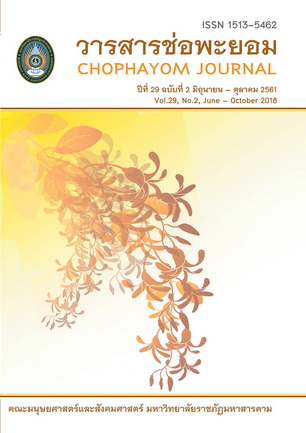A Waste Management Model of the People in Champasak District. Lao People’s Democratic Republic.
Keywords:
A waste management modelAbstract
The current study aimed 1) to investigate factors affecting waste management model of the people in Champasak district, Lao People’s Democratic Republic, 2) to develop a waste management model of the people in Champasak district, Lao People’s Democratic Republic, and 3) to investigate the effectiveness of the model applied to the area. The structure of the model for waste management was designed to have five casual factors including knowledge ,
communication, attitude, awareness, and participation. The samples were 399 tourists in Champasak district. A questionnaire designed in linear structural model was used in data collection. The data were analyzed by path analysis method.The study was separated into 3 phrases as follow. Phase 1 investigated factors affecting waste management model of the people in Champasak district, Lao People’s Democratic Republic. The result of the study showed that the
causal relationship model was related to the evidence. Four casual factors directly affected waste management model of the people in Champasak district. Lao People’s Democratic Republic. Province including knowledge (ß = .10), communication (ß = .05), attitude ( ß = .01), participation( ß = -.03),and awareness ( ß = -.05 ) respectively. Phase 2 aimed to develop a waste management model of the people in Champasak district, Lao People’s Democratic Republic by, using the result of the study in the previous stage. A workshop was held for 25 participants to analyze and criticize the result of the study in order to develop the model. It was found that 14 development activities could be applied to the waste management model, namely 1) knowledge: 5 activities related to waste management
knowledge, composting, little volunteer, waste and drink exchange, and waste separation, 2) 3 activities related to communication including public relation, fresh community to pay attention to the environment, 3) 2 activities related to attitude the color of fresh and fresh, and Reduce waste by hand. 4) 2 activities related to participation clean community with our mind and I love the Champasak district, and 5) 2 activities related to awareness create 3 and the green community is clean and eye-pleasing. Phase 3 aimed to investigate the effectiveness of the developed model on waste management in the area. The experimental group is the 20 th unit at Ban Phon Sawang, Pakse, Champasak Province. Lao People’s Democratic Republic. MANOVA (Repeated Measure). was used to analyze the comparison between waste management before and after the use of the model. The result of the study indicated that the waste management model of the people in Champasak district, Lao People’s Democratic Republic, improved waste water management in the area with the statistical significance at .05. Keywords : A waste management model






